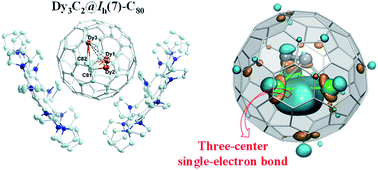Stabilizing a three-center single-electron metal–metal bond in a fullerene cage†
Abstract
Trimetallic carbide clusterfullerenes (TCCFs) encapsulating a quinary M3C2 cluster represent a special family of endohedral fullerenes with an open-shell electronic configuration. Herein, a novel TCCF based on a medium-sized rare earth metal, dysprosium (Dy), is synthesized for the first time. The molecular structure of Dy3C2@Ih(7)-C80 determined by single crystal X-ray diffraction shows that the encapsulated Dy3C2 cluster adopts a bat ray configuration, in which the acetylide unit C2 is elevated above the Dy3 plane by ∼1.66 Å, while Dy–Dy distances are ∼3.4 Å. DFT computational analysis of the electronic structure reveals that the endohedral cluster has an unusual formal charge distribution of (Dy3)8+(C2)2−@C806− and features an unprecedented three-center single-electron Dy–Dy–Dy bond, which has never been reported for lanthanide compounds. Moreover, this electronic structure is different from that of the analogous Sc3C2@Ih(7)-C80 with a (Sc3)9+(C2)3−@C806− charge distribution and no metal–metal bonding.

- This article is part of the themed collection: 2021 Chemical Science HOT Article Collection


 Please wait while we load your content...
Please wait while we load your content...